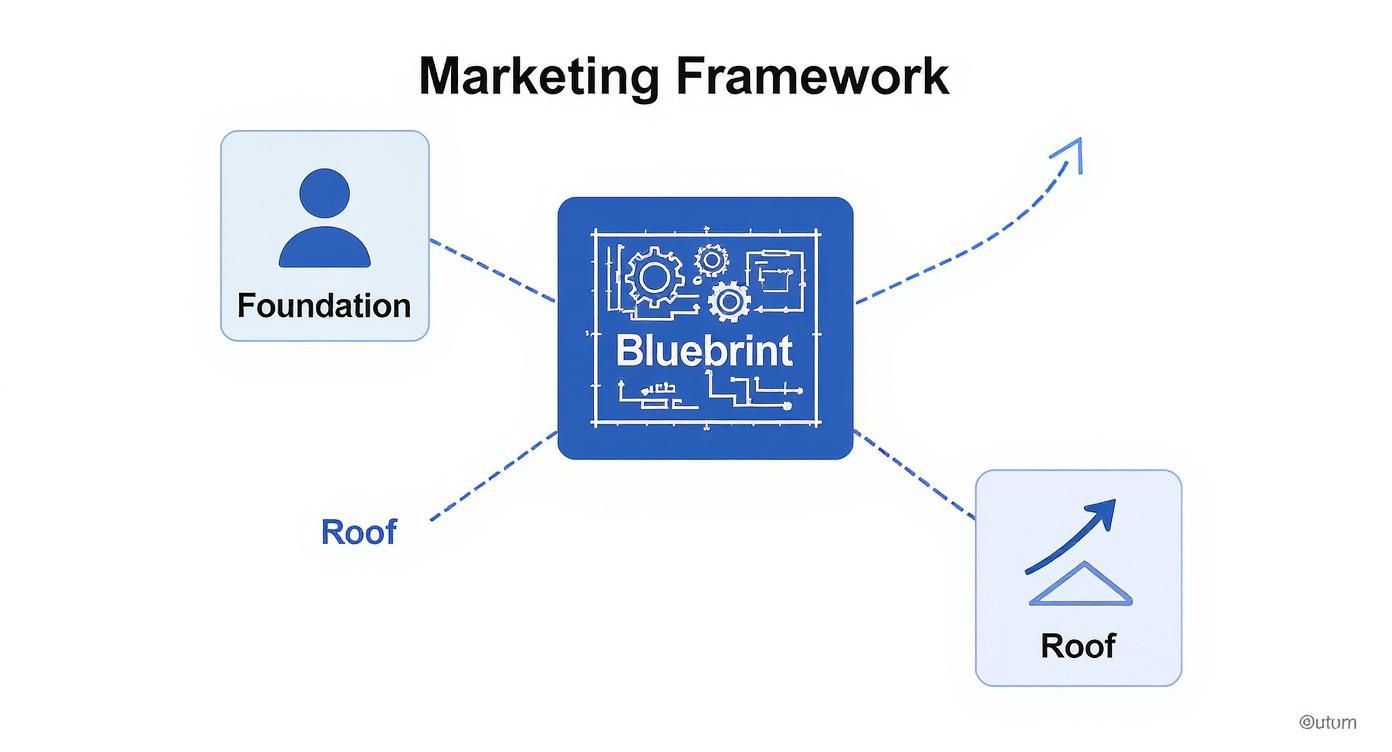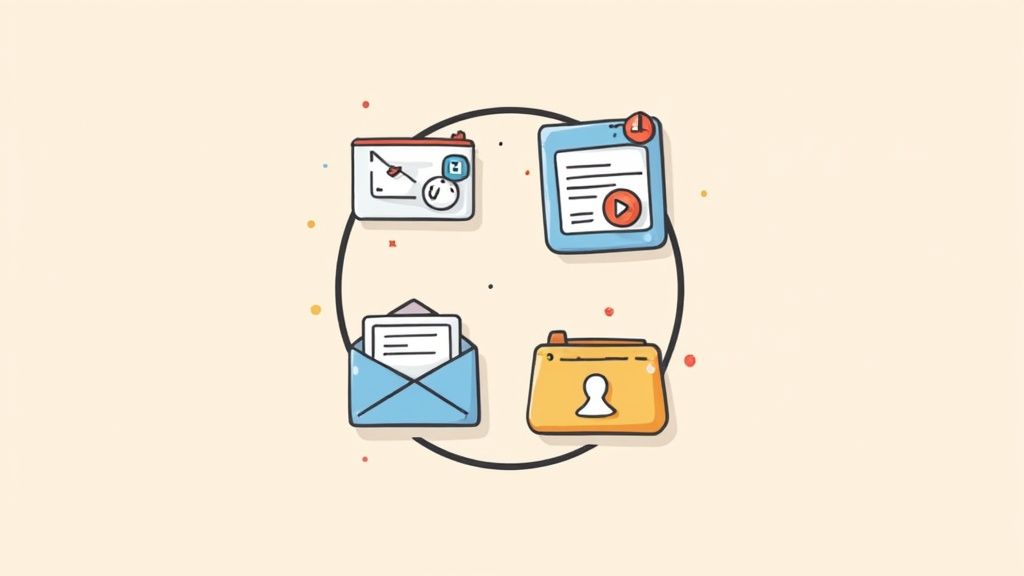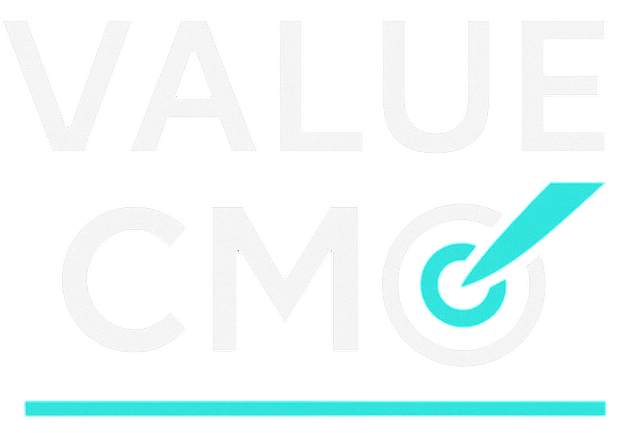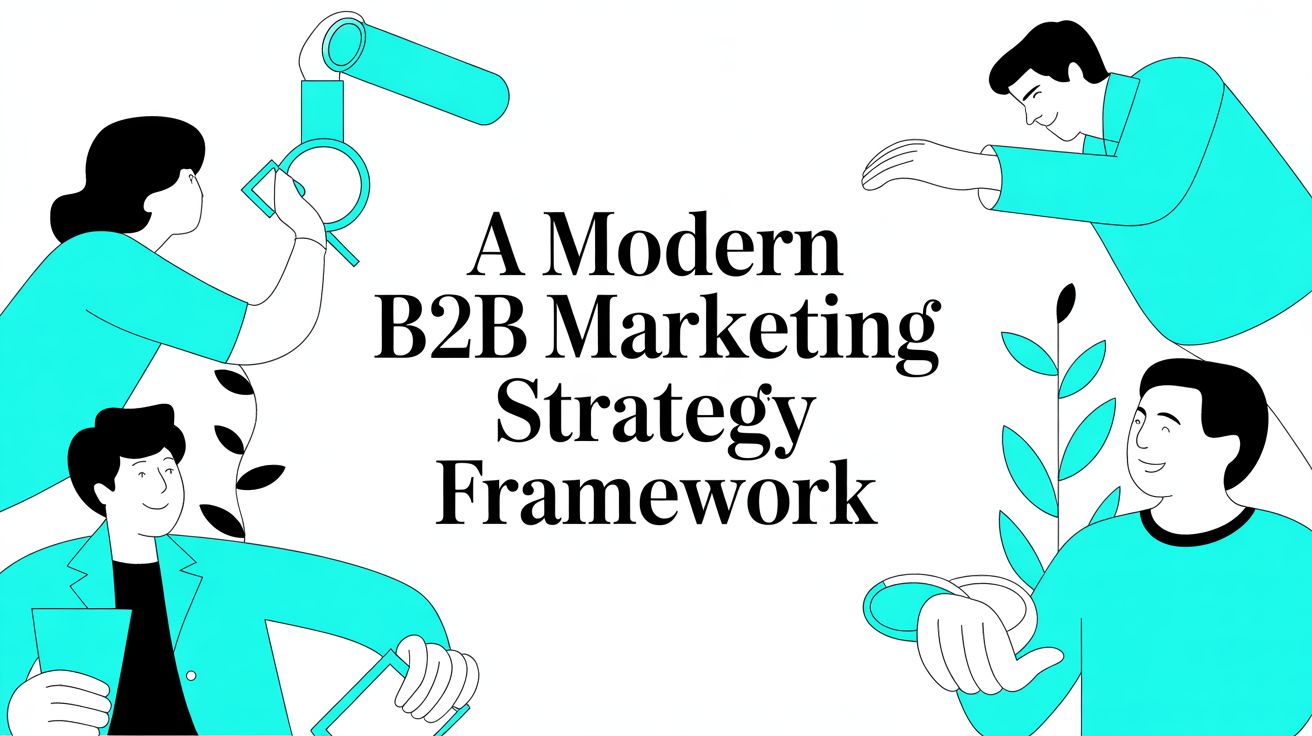A B2B marketing strategy framework is really just a blueprint. It’s what connects your day-to-day marketing hustle to your bigger business goals, making sure every campaign you run is smart, measurable, and actually gets results. It helps you break out of that “random acts of marketing” trap and build a repeatable system for winning over high-value customers.
Why Your Old B2B Playbook Is Failing

Let’s be honest: the old B2B playbook feels broken because, well, it is. The days of aiming a simple sales pitch at a single decision-maker are long gone. The entire buying journey has changed, and our marketing has to catch up.
Today’s B2B buyers are firmly in the driver’s seat. They do most of their homework online, on their own time, long before they even think about chatting with a sales rep. This isn’t just a passing trend; it’s a huge shift driven by buyers who expect self-service options and digital-first answers.
The numbers don’t lie. By 2025, it’s expected that more than 50% of large B2B purchases—we’re talking deals worth $1 million or more—will happen through digital channels like a company’s own website. This forces us to stop thinking about simple online transactions and start creating genuinely helpful buying experiences from start to finish.
The Rise of the Buying Committee
Another massive change is the death of the lone-wolf decision-maker. These days, big B2B purchases are made by a “buying committee,” a whole group of people from different departments, each with their own goals, worries, and questions.
A single deal can now hinge on getting a thumbs-up from finance, IT, operations, and the folks who will actually use the product. If you only market to one of them, you’re pretty much setting yourself up to fail.
This means your marketing has to speak multiple languages at once. You have to create real value for:
- The Financial Analyst: Who’s all about ROI and budget impact.
- The IT Manager: Who’s laser-focused on security, integration, and the technical nitty-gritty.
- The Department Head: Who just needs to know if your solution will solve their team’s biggest headaches.
Failing to connect with this entire group is one of the most common B2B marketing fails out there. If your message gets the CEO excited but the tech team vetoes it, that deal is dead on arrival.
The Need for a Structured Approach
Trying to navigate this new world without a structured B2B marketing framework is next to impossible. You’ll end up with mixed messages, wasted ad spend, and a sales team drowning in low-quality leads that go nowhere.
A framework brings clarity and focus to the chaos. It forces you to get crystal clear on who you’re talking to, what they need to hear, and how you’ll prove it’s all working. It’s not a nice-to-have anymore—it’s your roadmap for survival and growth.
Building Your Framework From the Ground Up
Think of your B2B marketing strategy framework as the blueprint for a custom-built house. You wouldn’t let a construction crew start pouring concrete without one, right? The same logic applies here. A framework makes sure every piece of your marketing—every ad, every email, every blog post—is strong, connected, and actually serves a purpose.
Without one, you’re just throwing money at random activities and hoping something sticks. A solid framework stops the guesswork and helps you build a predictable engine for growth.
So, let’s grab our hard hats and pour the foundation.
Start With Your Foundation: The Ideal Customer Profile
Before you can build anything, you have to know who you’re building it for. In B2B marketing, this means getting laser-focused on your Ideal Customer Profile (ICP). This isn’t just a fuzzy idea of who might buy your product; it’s a painfully specific definition of the perfect company for your solution.
A real ICP goes way beyond the basics. You need to be able to answer the tough questions:
- Firmographics: What’s their industry? Company size? Annual revenue? Where are they located?
- Technographics: What’s in their current tech stack? Are they using a competitor? Are they innovators or do they take a while to adopt new tools?
- Pain Points: What specific, costly problems are they dealing with that you are uniquely equipped to solve?
- Buying Signals: What actions show they’re in the market right now? Think recent funding rounds, hiring for specific roles, or sudden spikes in website traffic to certain pages.
Once you’ve nailed down the ideal company, you have to figure out the people inside it. These are your buyer personas. Every deal involves a buying committee, and each member—from the CFO worried about ROI to the IT Director concerned with integration—is a different persona. They all have their own goals, fears, and definitions of what success looks like.
Getting this foundation right is non-negotiable. If you target the wrong companies or use the wrong language with the right people, even the most brilliant campaign will fall flat on its face.
Erect the Walls and Structure: Your Value Proposition
Foundation set? Good. Now it’s time to build the walls. In marketing terms, this is your unique value proposition (UVP) and how you position yourself in the market. Your UVP is the clear, simple promise of the result a customer gets from using your product.
It’s the dead-simple answer to the only question your prospect really cares about: “What’s in it for me?” A powerful UVP isn’t a laundry list of features; it’s a specific, tangible benefit that your competitors can’t easily offer.
Your positioning is all about where you fit into the market landscape. Are you the premium, white-glove solution? The budget-friendly workhorse? The easiest-to-use option for non-technical teams? This choice dictates your messaging, your pricing, and your brand, making sure you stand out in a crowded field. To dig deeper on this, check out our guide on building a complete B2B marketing plan that puts these ideas to work.
Add the Roof: Business Goals and KPIs
Finally, every structure needs a roof to hold it all together. For your framework, that roof is your set of business goals and the Key Performance Indicators (KPIs) you’ll use to track your progress.
Your marketing goals can’t live in a vacuum. They have to directly support what the company as a whole is trying to achieve—whether that’s hitting a 30% increase in annual recurring revenue (ARR), breaking into a new market, or slashing customer churn.
From those big-picture goals, you can drill down to your marketing KPIs. These are the hard numbers that tell you if your strategy is actually working.
- Business Goal: Increase new customer acquisition by 20%.
- Supporting KPIs:
- Generate 500 Marketing Qualified Leads (MQLs) per quarter.
- Hit a 15% MQL-to-SQL (Sales Qualified Lead) conversion rate.
- Drive Customer Acquisition Cost (CAC) below $5,000.
These KPIs are what make your marketing accountable. They turn your strategy from a static document into a living, breathing system for driving predictable revenue. With this blueprint complete—foundation, walls, and roof—you’re ready to execute with real confidence.
The Four Pillars of Modern B2B Marketing
You’ve got the blueprint—foundation, structure, and roof are all planned out. Now it’s time to bring it to life. A strategy on paper is just that, a plan. These four pillars are the actions that turn that plan into a revenue-generating machine. Think of them as the specialized crews showing up on-site to do the actual building.
This graphic shows how the core parts of your blueprint fit together into a single, cohesive strategy.

The key takeaway here is that every piece relies on the others. When they work in sync, you get a stable and effective B2B marketing framework that actually drives growth.
Pillar 1: Content Marketing
Content marketing is the engine of your entire framework. It’s not about just churning out blog posts for the sake of it. It’s about creating valuable, relevant, and consistent content that solves your Ideal Customer Profile’s problems. Good content builds trust and positions you as an expert long before anyone’s ready to talk about buying.
When done right, your content becomes a magnet, pulling the right prospects toward you. The data backs this up: content marketing generates three times more leads than old-school marketing and costs 62% less. It’s the ultimate long-term play for building authority and earning trust.
Here’s how it works in practice:
- Top-of-Funnel (TOFU): You create blog posts, infographics, and social media updates that touch on broad industry pain points, attracting a wide but relevant audience.
- Middle-of-Funnel (MOFU): For people who are showing interest, you offer deeper resources like whitepapers, case studies, and webinars that start connecting their problem to your solution.
- Bottom-of-Funnel (BOFU): As prospects get close to making a decision, you serve up product demos, free trials, and detailed comparisons to help them choose you with total confidence.
Pillar 2: Demand Generation
While content educates and attracts, demand generation creates active interest and desire for what you sell. It’s the proactive side of the coin, focused on getting your name out there and sparking engagement across different channels. This pillar is all about making sure your ideal customers know you exist and understand why they need you.
This is a world away from just collecting email addresses. Instead of simply chasing leads, demand generation is about warming up your entire target market. You can dive deeper into the differences in this breakdown of demand generation vs. lead generation.
The goal of demand generation isn’t just to find buyers; it’s to create them by highlighting a problem they might not have even realized was costing them so much.
Common demand gen activities include running paid ads on LinkedIn, sponsoring industry webinars, hosting events, and pushing your best content to the places where your ICP already hangs out. It’s how you get the right message to the right people at just the right time.
Pillar 3: Account-Based Marketing (ABM)
If demand generation is like casting a wide, intelligent net, Account-Based Marketing (ABM) is like spear fishing. This is a hyper-focused strategy where your sales and marketing teams join forces to land specific, high-value accounts. Instead of marketing to a broad audience, you treat each target company as its own individual market.
This approach is incredibly effective for complex B2B sales. In fact, 87% of marketers say ABM delivers a higher return on investment than any other type of marketing. It forces you to align all your resources on the deals that truly matter.
A solid ABM strategy involves three key steps:
- Identify Target Accounts: Sales and marketing huddle up and build a list of dream clients that perfectly match your ICP.
- Personalize Outreach: You create custom content, ads, and messaging tailored to the specific challenges and goals of each target account. No generic outreach allowed here.
- Coordinate Engagement: Both teams orchestrate their touchpoints, ensuring a consistent and high-touch experience for the key decision-makers within that account.
This highly personalized approach builds deep relationships and has been shown to increase average contract values by as much as 171%.
Pillar 4: Sales Enablement
Finally, sales enablement is the critical pillar that connects all your marketing efforts directly to revenue. It’s all about arming your sales team with the content, tools, and training they need to close deals more effectively. A great marketing framework doesn’t just generate leads; it helps turn them into happy customers.
Think of it as the handoff in a relay race. Marketing has run the first few legs, and sales enablement ensures a smooth, fast handoff of the baton to the sales team for the final sprint to the finish line.
This means giving salespeople:
- High-Impact Content: Battle cards, case studies, and ROI calculators they can pull up in conversations with prospects.
- Timely Insights: Alerts when a target account is showing high engagement or a key decision-maker visits the pricing page.
- Training and Messaging: Clear guidance on how to talk about the product, handle common objections, and communicate your unique value.
When your sales team has what they need to win, the entire framework becomes more efficient. Sales cycles shorten, and win rates go up.
To pull it all together, here’s a simple table that breaks down how each pillar contributes to the overall strategy.
Comparing B2B Marketing Pillars
| Pillar | Primary Goal | Common Channels | Key Metric |
|---|---|---|---|
| Content Marketing | Build trust and attract an audience by solving problems. | Blog, SEO, Social Media, Whitepapers | Organic Traffic, Engagement |
| Demand Generation | Create active interest and awareness in the market. | Paid Ads, Webinars, Events, Content Syndication | Marketing Qualified Leads (MQLs) |
| ABM | Land specific, high-value “dream client” accounts. | Personalized Ads, Direct Mail, Custom Content | Target Account Pipeline |
| Sales Enablement | Equip the sales team to close deals more effectively. | Sales Collateral, CRM Integrations, Training | Sales Cycle Length, Win Rate |
As you can see, each pillar has a distinct job but ultimately works toward the same business outcome: driving predictable revenue growth.
Choosing Your Channels and Tactics
A brilliant marketing framework on paper is just that—paper. The real question is, where do you actually put your time and money to bring it to life? This isn’t about jumping on every new shiny trend. It’s about making smart, deliberate choices to connect with the exact customers you want to reach.

Think of your marketing channels as roads leading to your front door. You don’t need to build every single one. You just need to pave the few key routes your ideal customers are already traveling on.
Content and Video Still Run the Show
Content marketing isn’t just a channel; it’s the fuel for almost every other tactic you’ll use. It’s the bedrock of any solid B2B strategy, and the data backs it up: 91% of B2B marketers lean on content to drive their campaigns.
But how you deliver that content is changing. Blog posts and whitepapers still have their place, but video has become essential for grabbing attention and breaking down complex ideas. In fact, 61% of B2B teams are upping their video budgets just to keep up. Even AI is getting in on the action, with 62% of marketers using it to help brainstorm content ideas. You can get a closer look at these numbers in the latest B2B marketing statistics from SEOPROFY.
The takeaway is simple: your framework needs a solid plan for creating high-value content, with a heavy emphasis on video to keep your buyers watching.
LinkedIn: The B2B Lead Generation Engine
When it comes to social media, one platform is in a league of its own for B2B. LinkedIn is no longer just a place for digital resumes—it’s a powerhouse for building relationships and finding high-quality leads.
Its professional context makes targeted advertising feel helpful, not creepy. According to 62% of marketers, LinkedIn generates leads at double the rate of other social platforms. That makes it a non-negotiable channel for reaching decision-makers while they’re already in a business mindset.
Your LinkedIn playbook could include things like:
- Targeted Ads: Use its incredibly detailed firmographic and job title data to put your best content right in front of your ICP.
- Organic Thought Leadership: Have your company leaders consistently share real insights to build trust and authority in your space.
- Smart Outreach: Send thoughtful, personalized connection requests that actually start conversations instead of just pitching your product.
Don’t Sleep on Email Marketing
With all the noise about new channels, it’s easy to forget about the tried-and-true workhorse. Email marketing continues to deliver some of the highest ROI in the B2B world. It’s still the number one way to nurture a lead from “just looking” to “ready to buy.”
A good email campaign lets you build a direct, one-to-one relationship over time. You can send personalized content, share useful updates, and guide prospects through their buying journey. It’s the connective tissue that holds all your other marketing efforts together.
How to Pick Your Channel Mix
The best strategies don’t bet everything on a single channel. They build a mix where each one makes the others stronger. The right mix for you really comes down to your specific situation.
To figure out where to focus, ask yourself these three questions:
- Where does my ICP hang out? If you’re selling to C-suite execs, they’re definitely on LinkedIn. If you’re targeting developers, they’re probably in niche forums or online communities. You have to go where they are.
- What’s my budget? SEO and content are long-term plays that build over time. Paid social can get you results faster, but it’ll cost you.
- What am I trying to achieve? If you need broad brand awareness, you need channels with wide reach. If you’re driving leads for a high-ticket product, a more focused approach like ABM is a much better bet.
Ultimately, choosing your channels is about focus. It’s far better to dominate two or three key channels than to have a weak presence on ten. Start small, measure everything, and scale what works based on the data you see.
Integrating Account-Based Marketing
Broad marketing is great for filling the top of your funnel, but what about those game-changing clients? For most B2B companies, landing just a handful of dream accounts can make or break the entire year. This is where Account-Based Marketing (ABM) comes in, giving your core strategy a serious upgrade.
ABM isn’t some side project you run in a silo; it’s a deep integration with your main strategy. Think less like casting a wide net and more like spear fishing. Your sales and marketing teams join forces to treat each high-value target as its own mini-market.
This approach flips the traditional marketing funnel on its head. You start by identifying your perfect-fit future customers and then build hyper-personalized campaigns designed to win them over, one by one.
Beyond Acquisition to Full-Funnel Growth
The real magic of ABM happens when you stop seeing it as just a tool for landing new logos. It’s a full-funnel strategy, and its role is only getting bigger—driving not just acquisition but customer retention and expansion, too.
The industry is already all-in. Right now, about 67% of B2B brands are using ABM tactics. Better yet, an overwhelming 93% of SaaS marketers call it a highly successful play. The proof is in the numbers: marketers report an 85% jump in customer retention directly from their ABM efforts, showing its power to build relationships that last. You can dig into more predictions on ABM’s B2B impact by reading the full research on RollWorks.com.
This means your ABM program needs goals for the whole customer journey:
- Acquisition: Landing those must-win accounts with surgical precision.
- Retention: Making sure your most valuable clients feel understood and supported, crushing any chance of churn.
- Expansion: Spotting upsell and cross-sell opportunities inside your key accounts before anyone else does.
How to Weave ABM Into Your Framework
Making ABM work requires a tight-knit partnership between sales and marketing. It’s a team sport where both sides share intel and coordinate every move. The goal is to create a seamless, high-touch experience for the people who matter most to your business.
ABM is the ultimate expression of customer-centricity. It forces you to stop shouting at the market and start having meaningful conversations with the companies you want to work with most.
Here’s a practical look at putting it into action:
- Identify and Tier Your Target Accounts: Get in a room with sales and build a focused list of dream clients. Then, tier them. Tier 1 gets the full white-glove treatment, based on revenue potential, strategic value, and how well they fit your ICP.
- Map the Buying Committee: For each target, figure out who’s who. Who holds the budget (the economic buyer)? Who’s kicking the tires on the tech (the technical evaluator)? Who are the end-users you need to win over?
- Gather Account Intelligence: Go deep. Use data to understand each account’s specific pain points and goals. What are their execs talking about on LinkedIn? Did they just hire a new VP? This stuff is gold.
- Create Personalized Campaigns: Armed with all that insight, you can craft messaging that actually resonates. This could be anything from a custom-tailored webinar for one company to a direct mail campaign that speaks directly to their industry’s biggest headaches.
By integrating ABM, your whole framework gets smarter. You stop wasting time and money on low-fit prospects and focus your A-game on the accounts that can truly move the needle.
Putting Your B2B Framework into Action
A brilliant B2B marketing framework is just a pretty document until you actually use it. The final, and most important, step is turning that blueprint into action in the real world. Execution is where your plan meets reality, and it’s less about a perfect launch and more about continuous learning and adapting.
Your framework should be a living document, not something you carve in stone and forget about. Markets shift, customer problems change, and new data will always give you a clearer picture of what’s actually working. The real win comes from building a habit of review and adaptation right into how you operate.
Think of it like a ship’s navigator. You have a destination (your goals) and a map (your framework), but you still have to constantly check the instruments and adjust for winds and currents to stay on course.
Getting Started: A Practical Checklist
Ready to move from planning to doing? Don’t try to boil the ocean. The key is to start with a focused, manageable launch that builds momentum and gives you some initial data to work with.
Here’s a simple checklist to guide your first moves:
- Audit Your Current Efforts: Before you build anything new, take a quick inventory. What are you already doing that fits the new framework? What needs to be paused, like, yesterday?
- Launch a Pilot Campaign: Pick one key objective from your framework. Maybe it’s targeting a new persona or testing a specific channel. Launch a small, measurable campaign around it to see what happens.
- Establish a Review Cadence: This part is non-negotiable. Schedule regular check-ins—maybe weekly for tactics and monthly for overall strategy—to dig into the performance data against your KPIs.
- Iterate and Optimize: Use what you learn from those reviews to make smart adjustments. This is the whole point of a solid b2b marketing strategy framework; it’s a journey of iteration, not a one-time quest for perfection.
Got Questions? Let’s Talk Strategy.
Even the best plan runs into questions when the rubber meets the road. This is where we tackle those common “what ifs” that pop up when you’re putting a new B2B marketing framework into play.
Think of this as the final gut-check before you start building.
What’s the One Thing We Absolutely Can’t Get Wrong?
Your Ideal Customer Profile (ICP). Every single time. If your ICP is fuzzy, everything you build on top of it—your messaging, your content, your ad targeting—will be wobbly at best.
A vague ICP means you’re burning cash on ads that don’t land and sending leads to your sales team that go nowhere. But a truly dialed-in ICP? It’s like having the answers to the test. It makes every other decision easier and way more effective because you know exactly who you’re talking to and what they actually care about.
How Often Should We Be Tweaking This Thing?
A B2B marketing framework is a living document, not a stone tablet. It needs regular attention to keep it sharp and effective. You can’t just set it and forget it for a year.
Here’s a practical rhythm that works for a lot of teams:
- Quarterly Strategy Review: Every three months, zoom out. Are your big-picture goals still the right ones? Have any competitors made a big move? This is for making major course corrections.
- Monthly Performance Dive: Get into the weeds with your KPIs once a month. Are you hitting your numbers for MQLs, pipeline, and cost per acquisition?
- Weekly Tactical Syncs: Meet with the team every week to look at campaign-level performance. This is where you optimize ad creative, adjust email copy, and make all the small pivots that keep you moving forward.
The point isn’t to constantly change for the sake of it. It’s about consistent, data-backed iteration. A series of small, smart adjustments will always beat one giant overhaul a year from now.
How Does a Small Team Even Use a Big Framework Like This?
It’s easy to look at a comprehensive framework and feel totally overwhelmed, especially if you have a small team and an even smaller budget. The trick is to simplify, don’t skip.
You don’t need to do everything all at once. Start by nailing the absolute essentials: your ICP and your core value proposition. Get those right first.
Then, pick just one or two channels where you know your audience lives. Maybe that’s just SEO-driven content and a focused effort on LinkedIn. Master those before you even think about adding more channels to the mix. A simple, well-executed b2b marketing strategy framework is a thousand times more powerful than a complex one that’s just collecting dust on a shelf.
Building a framework that drives real growth takes more than just a template. Value CMO gives B2B tech startups the fractional CMO leadership needed to build a focused roadmap and execute with confidence. Get the strategic guidance you need to scale.

